Articles

LucasArts' Secret History #13: Grim Fandango Art deco, Mayans, Revolution
Art Deco, Mayans, Revolution
Excuse the pompous title, for this is not meant to be an academic article, even though it may look like it at first glance. Actually, I don't know squat about architecture, but that's not preventing me from writing about it in connection with Grim Fandango, because I'll be damned if the architecture in Grim Fandango doesn't look good. And so, dear reader, I am writing this as a fan, and not as a connoisseur. You are warned.
So anyway, about this architecture business, I think it's safe to say that Grim Fandango is set in a world that is heavily Mexican in nature. The mariachis around the ashtray, the Spanish words, the Day of the Dead, it all points to Mexico. And so does the architecture. There's your typical Mesoamerican temples and motifs, your art nouveau and art deco with a Toltec flavour, and...
Wait, what?
Oh, listen to me, rambling on about things I don't even really understand but pretend to. Let's slow down a bit here to figure out what all this stuff is.
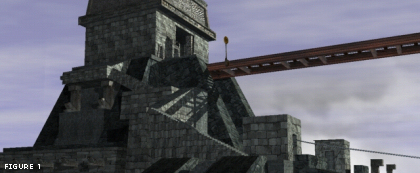
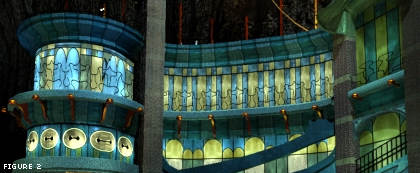
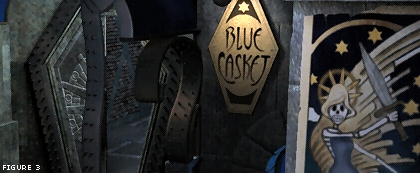
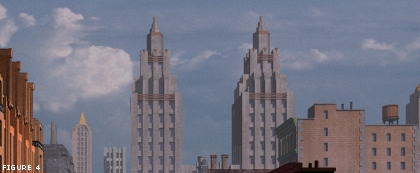
- Mesoamericans: These guys lived in what we now call Mexico, long before Europeans arrived there. You have the Mayans, who really were the first ones there, with their temples and colourful art, and then a bit later the Aztecs, with their temples and colourful art. As you can see, the Aztecs took quite a few pages out of the Mayan books. Another term that you'll hear in connection with these Mesoamerican civilizations is Toltecs, but it'll suffice to lump all these groups into one, for the purpose of this article. After all, I'm not giving a lecture here!
- Art Nouveau: This style, also known as Jugendstil (yes, that's German), was popular around the turn of the century (that's 19th into 20th, so around 1900). Some staples in this art and architecture style are a heavy use of glass and natural shapes and motifs. Two prime examples of this are found in Grim Fandango. Figure 2 shows the Blue Casket in all its glassy glory (try to say that ten times, fast), and in figure 3 there is a poster that is reminiscent of the work of Alfons Mucha, the famous art nouveau artist.
- Art Deco: If you've watched the TV adaptation of Agatha Christie's Hercule Poirot, you'll know this. Popular in the 1920s en 1930s, it is quite different from art nouveau. Art deco is more modernist, with lots of straight lines. It's also partly inspired by Mayan and Aztec art, and that's where Grim Fandango comes in. In Rubacava, there are examples of towers that were inspired by step pyramids (see figure 4). Step pyramids were of course popular with the Babylonians, but also with Mesoamerican civilizations, who inspired art deco architecture. So you see, it all fits together. Like a puzzle.
After this crash course in Mexican architecture, let's move on to the next part...
The old and the new
Great, so Grim Fandango uses both old, Mesoamerican, and modern, art nouveau and art deco architecture. But isn't that a bit of a mishmash? Not quite. In this case, the twain shall actually meet, and they meet in Mexico.
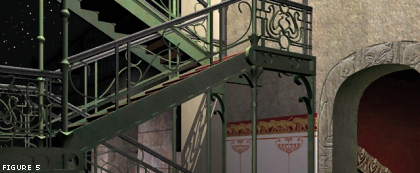
For instance, in both Maya art and art nouveau, one finds an interesting recurring element: the whiplash line. Its name betrays what it is: a gracious, long line, with long curves, and a bit curly at the ends – inspired by nature. In Grim Fandango, you can find this line in the staircase that's depicted in figure 5. Those gorgeous, rich, bendy lines also return in the carpet in that background.
As for art deco, by nature it was suited for incorporating pre-Hispanic art into it. After all, art deco was partly inspired by Mesoamerican art, and all those flat surfaces and straight lines leave lots of space for decoration. As such, it was sort of adopted as the national style of Mexico.

And speaking about the old and the new, the Mexican Revolution – which will be discussed hereafter – brought about a change in architecture as well. Engineers, with their modern architecture, took over from architects, who clung to older styles, and thus brought about a change in the looks of the Mexican cities.
Revolution Solution
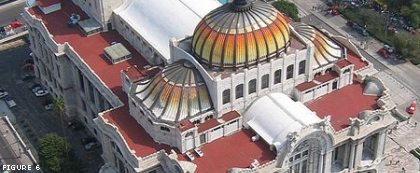
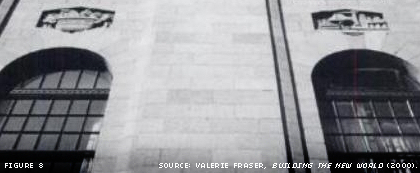
Ah, the revolution. Another thing that is intricately bound up with Latin America, and of course a big theme in Grim Fandango as well. Mexico also had a revolution of its own, and it took place in 1910. It lasted until the 1920s however, but its effects would reach much further. It brought about a revolution in Mexican architecture.
Up until then, Mexican architecture had mostly been imitating European architecture. An example of this is the Palacio de Bellas Artes (see figure 7), construction of which started shortly before the revolution. After the revolution however, art deco came into fashion, but it was art deco with a Mexican twist: traditional, pre-Hispanic elements were incorporated into the modern buildings – this tendency is described as Toltecism, because it borrowed ornamental designs from the Aztecs and Toltecs.
An example of this combination of the modern and the ancient can be found in the Mexican Ministry of Health building, which was designed by Carlos Obregón Santalicia, an influential Mexican architect who received several commissions for government buildings. Take a look at it in figure 8. Then look at figure 9, which is a picture from Grim Fandango. Look familiar? It would seem that Rubacava had a few Toltecists in its city council.
But what part did the revolutionaries play in all this? Well, they of course wanted to show how modern they were, and again they looked at European architecture for guidance. The art deco movement, with its concrete skyscrapers and straight lines, was the epitome of modernity. But to keep their own identity, they threw in some spicy Aztec and Maya designs. Boil it over a kettle, stir, and presto: there's your Grim Fandango architecture.
Closing Thoughts
Of course, none of this stuff really matters if you just want to enjoy Grim Fandango, but it's nice to know that the creators did their homework. That makes the architecture in Grim Fandango that much more genuine beautiful, and you must admit, it is beautiful. From the modernist high-rises in Rubacava to the beautiful Jugendstil glasswork in the Blue Casket and the greenhouse, and the majestic Mayan temple, Grim Fandango's Mexican-inspired architecture never fails to impress.
Futher Reading
- Craven, Jackie, 'Art Deco Architecture' http://architecture.about.com/od/artdeco/ss/artdeco.htm.
- Fraser, Valerie, Building the New World (2000).
- Guillen, Mauro F., 'Modernism without Modernity: The Rise of Modernist Architecture in Mexico, Brazil, and Argentina, 1890-1940', Latin American Research Review 39/2 (2004) 6-34.
- Houston, Stephen D., David Stuart, Karl A. Taube, The memory of bones (2006).
- Lonely Planet Publications Staff, Kate Armstrong, John Noble, Ray Bartlett, Greg Benchwick, Mexico (2008).
- Mutlow, John V., The New Architecture of Mexico (2005).
-- Haggis